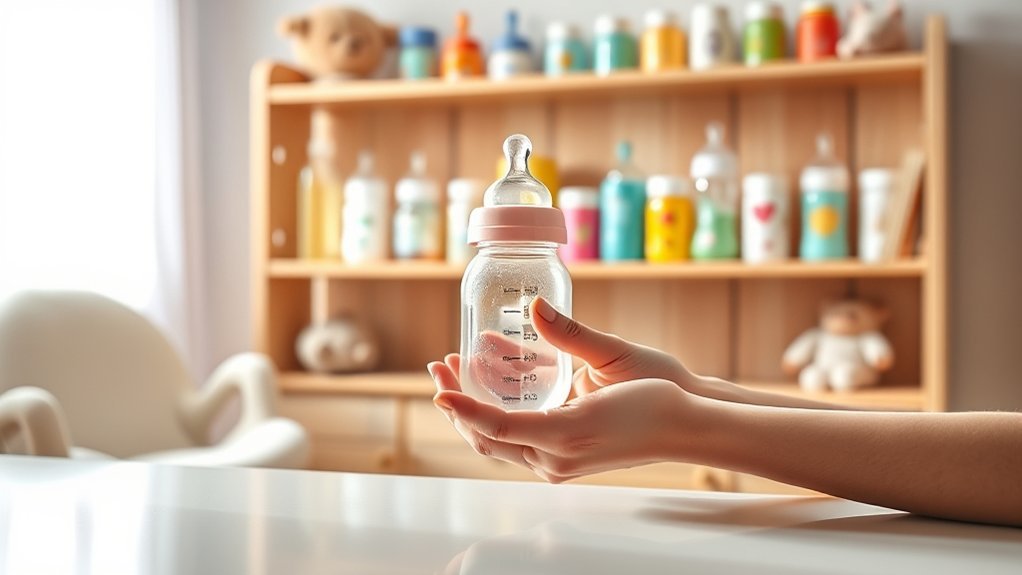Did you know that nearly 75% of parents report feeling overwhelmed by the choices in baby bottles? This decision isn’t just about convenience; it can greatly affect your baby’s feeding experience and health. With various materials, shapes, and sizes, choosing the right bottle requires careful consideration. Understanding these factors can make all the difference in nurturing a positive feeding relationship with your little one. What should you prioritize when making your selection?
Understanding Bottle Materials and Their Impact
When you’re choosing baby bottles, it’s essential to contemplate the materials they’re made from, as this can greatly affect your baby’s health and feeding experience. Most bottles are made from plastic, glass, or stainless steel. Plastic bottles are lightweight and shatterproof but may contain harmful chemicals like BPA, so opt for BPA-free options. Glass bottles are durable and easy to clean, but they can be heavy and breakable. Stainless steel bottles are sturdy and insulated, keeping milk at the right temperature, but they often come at a higher price point. Consider your lifestyle and preferences when selecting a material. Ultimately, choose a bottle that prioritizes safety and convenience to support your baby during feeding.
Nipple Shapes and Flow Rates: Finding the Right Fit
Choosing the right nipple shape and flow rate for your baby’s bottle can markedly enhance their feeding experience and comfort. Nipple shapes vary, with options like standard, orthodontic, and wide-neck. Each design promotes a different latch, so observe your baby’s preferences. A standard shape mimics breast feeding, while orthodontic designs support oral development.
Flow rates are equally essential. Slow flow nipples suit newborns, fostering a steady pace, while medium and fast flow options cater to older infants. Pay attention to your baby’s cues; if they’re struggling or gulping, consider adjusting the flow rate. Ultimately, finding the perfect combination of shape and flow guarantees a smoother feeding experience, making mealtime enjoyable for both you and your little one.
The Role of Bottle Size in Feeding Comfort
Bottle size plays a crucial role in your baby’s feeding comfort and overall experience. Choosing the right size can help prevent issues such as excessive air intake, which may lead to gas and discomfort. It’s essential to take into account your baby’s age and feeding habits when selecting bottle sizes.
Selecting the right bottle size is vital for your baby’s comfort and can help prevent feeding issues.
- Newborns typically benefit from smaller bottles (4-6 ounces) to avoid overwhelming them.
- Growing infants might require medium-sized bottles (8 ounces) to accommodate their increasing appetite.
- Toddlers often do best with larger bottles (10-12 ounces) for their more substantial feeding needs.
Transitioning Between Breast and Bottle: Tips for Success
Although shifting between breast and bottle can feel intimidating, with the right approach, it can be a smooth process for both you and your baby. Start by introducing the bottle during a calm moment, perhaps when your baby isn’t too hungry or upset. Choose a slow-flow nipple to mimic the breastfeeding experience. Encourage skin-to-skin contact during bottle feeding to enhance bonding.
| Tip | Benefit |
|---|---|
| Start slow | Reduces anxiety for baby |
| Use breast milk | Familiar taste eases change |
| Involve others | Builds trust and comfort |
Cleaning and Maintaining Baby Bottles for Safety
When it comes to your baby’s health, keeping their bottles clean and well-maintained is crucial for safety. Bacteria can thrive in improperly cleaned bottles, leading to potential health risks. Here are some key cleaning tips to follow:
- Wash immediately: Clean bottles right after use to prevent milk residue buildup.
- Use hot, soapy water: Verify you’re using a safe dish soap, and consider a bottle brush for hard-to-reach areas.
- Sterilize regularly: Especially for newborns, sterilizing bottles can eliminate harmful germs.
Frequently Asked Questions
How Do I Choose a Bottle Based on My Baby’s Age?
To choose a bottle based on your baby’s age, consider their developmental stage. Newborns need slow-flow nipples, while older infants may benefit from faster flows. Always verify the bottle’s size and shape suit your baby’s needs.
Can I Use Regular Bottles for Breast Milk Storage?
You can use regular bottles for breast milk storage, but make certain they’re BPA-free and airtight to maintain quality. Just remember, glass or specific breast milk storage bags might offer better preservation for longer periods.
What Are the Signs of a Bottle That Needs Replacing?
If you notice cracks, discoloration, or a strong odor, it’s time to replace your bottle. Also, if the nipple shows wear or tears, it’s best to guarantee your baby’s safety and comfort by getting a new one.
Are There Specific Bottles for Colicky Babies?
You’ll find specialized bottles designed for colicky babies, featuring anti-colic valves and unique shapes to reduce air intake. These bottles can help ease discomfort, making feeding a smoother experience for you and your little one.
How Many Bottles Should I Have on Hand?
You should have at least 4 to 6 bottles on hand. This guarantees you’ll always have a clean one ready, especially during feeding times, while allowing for easy cleaning and rotation as needed.
Conclusion
Choosing the right baby bottle is essential for your little one’s feeding journey. Did you know that around 70% of parents report their baby prefers a specific nipple shape? This highlights the importance of finding the perfect fit for your child’s needs. By considering materials, nipple shapes, and proper maintenance, you can enhance your baby’s feeding experience and foster a strong bond. Remember, informed choices lead to happier feeding times and healthier babies!
